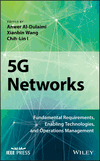Emerging Technologies in Software, Hardware, and Management Aspects Toward the 5G Era: Trends and Challenges
Abstract
5G networks would be a heterogeneous networks (HetNets), meaning that different networks will be integrated all together to a unified system, enabling aggregation of multiple existing radio access technologies (RATs) such as LTE-A, Wi-Fi, D2D, and even lightly licensed. 5G will be designed to be a viable, robust, and scalable technology. Another positive result with the introduction of 5G communication systems will be the drastic energy consumption reduction and energy harvesting that will help the industry to have an astounding usage growth. This chapter elaborates on the main 5G requirements and presents the status and challenges in hardware and software development. It focuses on the status and challenges in 5G wireless communications by focusing on physical layer, MAC and radio resource management (RRM). The chapter investigates the benefits of machine learning in 5G network management. It describes the use of various machine learning mechanisms for the service classification problem and also investigates the performance of different algorithms.



